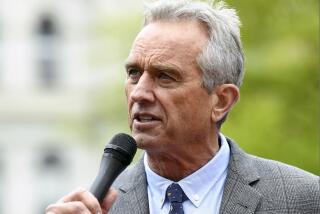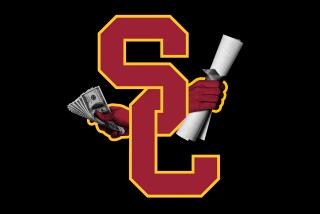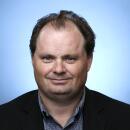Respected Mentor Now Abuse Suspect
- Share via
Eight years ago, renowned USC geneticist William French Anderson, an avid martial arts practitioner, sought out expert karate teacher Paul Godshaw for private instruction, and declared his goal: winning a gold medal at the Amateur Athletic Union national tournament.
The scientist, then nearing 60, went to Godshaw’s Mission Viejo training facility once a month for more than a year. Two or three times, he brought along a shy girl of about 10 -- whom he said he was training at his San Marino home -- for professional instruction.
The karate instructor found Anderson “a tremendous athlete” and the girl “rather timid.” But at the 1998 AAU national tournament in Orlando, Fla., both the scientist and the girl won gold medals in their age categories.
Their success reflected many of the personal characteristics for which Anderson, who has been called “the father of gene therapy,” is known -- the single-minded pursuit of goals, a preoccupation with martial arts and personal safety, and a history of assisting what he has called “surrogate children.”
However, Anderson’s relationship with the girl, now a 17-year-old high school senior, is no longer one of mentor and protege, but of accused and accuser.
Anderson has been charged with sexually molesting the girl, the daughter of a colleague at USC’s Gene Therapy Laboratories, from when she was 10 to when she was 14. He faces one charge of continuous sex abuse on a child and five counts of lewd acts upon a child, charges that could imprison him for the rest of his life.
Anderson has pleaded not guilty; a date for a preliminary hearing in the case is to be set next month. He has declined The Times’ requests for interviews, and his defense attorney has not returned calls for comment.
In a recent e-mail to friends at the university, a copy of which The Times obtained, Anderson wrote: “It is a nightmare being falsely accused. I have not done the things I am charged with.”
*
Anderson’s closeness to the girl and her parents, especially her mother, was apparent to others.
The girl’s mother is “an incredibly gifted scientist” at USC’s Gene Therapy Laboratories -- which Anderson started in 1992 -- and Anderson’s most trusted assistant, said Al MacKrell, a biology professor at Bradley University in Illinois who was the lab’s first post-doctoral researcher.
“She was the one person he felt he could entrust with important projects,” MacKrell said.
At age 13, the woman’s daughter took up soccer. Over the next three years, Tom Ashby, former girls’ soccer coach at the Los Angeles-area high school the girl attends, watched her develop into a star who helped her team win a California Interscholastic Federation championship.
Anderson, known to many as French, consistently attended soccer practices, usually showing up for the last hour and then driving the girl to her home nearby, Ashby said. “It’s something you notice when it’s not a parent,” he said. “I’d see him more often than her parents.”
Coaches and players knew Anderson was a friend of the girl’s family, that her mother worked with him and that he had helped family members, who are immigrants, adapt to life in California. The relationship appeared “pretty normal,” said former team captain Ruth Apraku, 18, who graduated this year.
The manager of a private soccer club in which the girl played had a different impression.
“Wherever [the girl] was, there was Dr. French,” Scott Dority, the club manager, said in an interview. “It bothered me from Day One.”
During the high school’s last soccer season, which ran from August to March, Anderson stopped attending practices and games, according to coaches and a player. In the spring, the girl talked to a counselor, the counselor contacted county social services personnel and they contacted police, authorities said.
Detectives monitored responses to a series of e-mails sent by the girl to Anderson at their direction, according to law enforcement sources familiar with the case. Police also taped a conversation the girl initiated at the instruction of detectives. She wore a concealed transmitter.
Contacted by a Times reporter, the girl’s mother would not answer questions, saying only, “The truth will prevail. I trust the justice system.”
*
Anderson’s signal scientific achievement came in 1990, when a team he led cured a hereditary disease of the immune system in a 4-year-old girl. They infused the girl with white cells that had been removed from her blood and supplied with a missing gene. It was the first time gene therapy had been successful in humans, guaranteeing Anderson a place in medical history.
Anderson’s achievement also has made him a lightning rod in the controversy over the ethics of genetic manipulation. He has received death threats because of his work and developed a keen interest in personal security measures.
When dealing with very young patients during his 27 years at the National Institutes of Health in Bethesda, Md., Anderson was known for his gentleness and unassuming approach, wrote Jeff Lyon and Peter Gortner in their book “Altered Fates: Gene Therapy and the Retooling of Human Life.” Anderson typically crouched to a child’s eye level when greeting him or her for the first time, according to the authors.
Early in his marriage, Anderson has told various writers, he and his wife, Kathryn, who recently retired as chief surgeon at Childrens Hospital Los Angeles, decided not to have children so they could concentrate more fully on their work. While at NIH, the couple has said, they began mentoring numerous “surrogate” children, and in some cases paid for their college educations.
Anderson can be shy to the point of non-engagement, yet can enthrall an audience of peers or laymen, according to colleagues, biographers and others who know him. He is mildly dyslexic and a painfully slow reader, according to biographers, but holds 12 patents and has an IQ of 178.
Anderson is a crack pistol shot and a devoted friend of law enforcement who self-published a detailed analysis of a famous FBI shootout. A Harvard- and Cambridge-educated medical doctor, he is also licensed as a security guard in California.
“French does not have hobbies, he has obsessions,” his wife told biographers. “Everything he does has to be the best that it can be done.”
In 1969, after a nurse was attacked near the NIH campus, Anderson, who had been a cross-country runner and track team member at Harvard, began taking lessons in the Korean martial art taekwondo.
By 1978, he was a black belt, eventually attaining the fifth degree. He co-founded a taekwondo school at NIH, where he helped train children and adults. His dedication to the sport helped keep his 5-foot-9-inch frame lean and muscular.
Over time, he became a certified taekwondo referee, designed what came to be mandatory tournament headgear for participants and served as physician for the U.S. taekwondo team at the 1988 Olympics in Seoul.
At his San Marino home, which is assessed at $1.9 million, he built a rubberized outdoor sparring mat surrounded by benches in the midst of an orchard, where he works out and trains others.
Anderson has been a friend of the San Marino Police Department. He funded a new gym for its officers and trained its personnel in self-defense. He has been a civilian volunteer with the department and until his arrest was the only city resident who held a department permit to carry a concealed weapon. San Marino Police Chief Arl Farris’ own two children, accomplished karate students, sparred with Anderson a few times at his home facility.
When the molestation accusations against Anderson arose, Farris referred the case to the Los Angeles County Sheriff’s Department to avoid any suggestion of conflict of interest.
According to authors Bob Burke and Barry Epperson, whose biography of Anderson, “W. French Anderson: Father of Gene Therapy,” was published last year, the geneticist has long had close ties with law enforcement. While at NIH in Bethesda, he sometimes trained local police officers in martial arts.
*
Anderson came to USC in 1992, backed by millions of dollars from the Swiss pharmaceutical company Sandoz (now part of pharmaceutical giant Novartis), which had bought the rights to his patented method of gene transfer. He started USC’s Gene Therapy Laboratories, where work has centered on stem-cell research and the possibility of correcting defective genes in fetuses.
The lab soon became a beacon to researchers. “Anyone who was really looking to do serious gene-therapy research wanted to come to USC,” said former lab researcher MacKrell.
In the ultra-competitive upper reaches of medical research, Anderson has always attracted passionate loyalists who praised his integrity, mentoring skills and dedication -- and the enmity of detractors.
“He is a first-class scientist,” said Laurence H. Kedes, director of USC’s Institute for Genetic Medicine. “As a scientist, he is thoughtful and insightful and full of creative ideas. He is very easy to get along with.”
By contrast, Dr. Frederick Hall, a USC medical professor from 1989 to 2002, and Dr. Erlinda Gordon, a USC emergency medicine physician and tenured faculty member, sued Anderson. They accused him of interfering with funding for their research and clinical trials on a gene-therapy treatment for pancreatic cancer that the pair said they developed. They also contend Anderson had no right to file for a patent on the treatment.
Their suit was dismissed, a ruling that is being appealed.
“I think he’s an opportunist. I think he’s basically corrupt,” Gordon said in an interview.
Robert O’Brien, a lawyer who represented Anderson and USC in the matter, said Hall and Gordon’s lawsuit was frivolous. “We feel the appeal has very little likelihood of success,” he said.
Since his arrest July 30, Anderson has been on administrative leave from USC, which means he may not have professional contact with colleagues regarding research or other university business.
Work at the lab has continued unabated in his absence, Kedes said. Other researchers said Anderson has always encouraged scientists in the lab to work independently of him and develop as colleagues rather than subordinates.
MacKrell described Anderson as extremely hardworking, easygoing and accessible. “His authority all came from respect from the people who were working under him,” MacKrell said.
Kedes said Anderson has been “an impeccably ethical person ever since I’ve known him, and even before, by reputation. I have no belief that these charges will stick.” He said he and other USC faculty members have e-mailed Anderson expressions of their support.
In his response to such messages, Anderson echoed Kedes’ confidence.
“I know that my name will be cleared when this horrible experience is over,” Anderson wrote in an e-mail to colleagues.
“As I sat alone in my jail cell for three days, I came to appreciate what is truly important in my life. As I thought, my devastation turned to anger and my anger turned to determination. I am determined not to allow a false accusation to destroy what I have spent my life building.”
More to Read
Go beyond the scoreboard
Get the latest on L.A.'s teams in the daily Sports Report newsletter.
You may occasionally receive promotional content from the Los Angeles Times.







